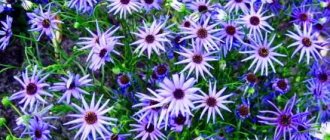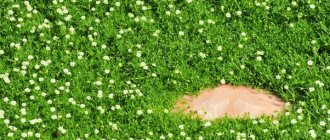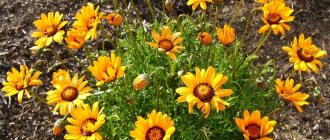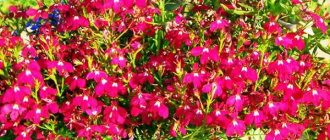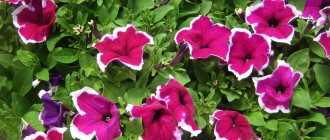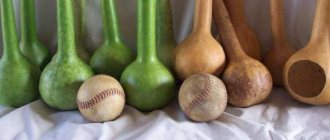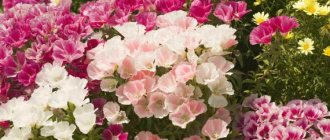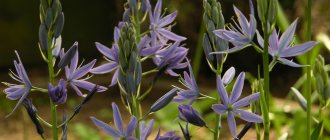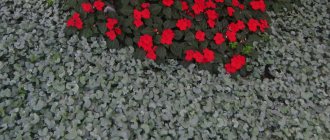Verbascum is a perennial (lives 2 or more years) herbaceous plant of the Norichinaceae family. Translated from Latin, the name of the plant means “bearded.” Other nicknames are popular among people: fire-grass, golden flower, bear's ear, royal scepter, archer, mullein.
The root system is taprooted and penetrates deeply into the soil. The stem is erect, reaching a height of 50 cm to 2 m. The leaf blades are oblong in shape with a pointed apex, the surface is leathery, dark green in color, and are attached alternately. The inflorescence is spike-shaped. The flowers are delicate, five-petaled, the colors can be yellow, pink, purple, violet. They bloom from bottom to top, with each individual corolla opening in the morning, and in the evening it closes and falls off, and the next day a new one appears. The fruit is an oval-shaped capsule with seeds.
When does verbascum bloom?
The fluffy spike-shaped inflorescences of verbascum delight throughout the summer.
The natural habitat is the Mediterranean and the temperate subtropical zone of Asia.
Verbascum is increasingly gaining popularity in landscape design. It is quite unpretentious in care, as they say, even the lazy will grow it. Mullein is perfectly adapted to dry, hot climates; they feel more comfortable in open sunny areas, shading is possible (this way the flowers do not fall off longer). Easily tolerates drought and sudden temperature changes. At the end of flowering, the stem dies completely.
Healing properties of mullein
Verbascum is part of many medicines with antitussive and expectorant effects. The mixture helps with colds, flu, bronchitis, and whooping cough. The plant has an anti-inflammatory effect and is widely used in the treatment of inflammatory pathologies of the oropharynx, stomach, and urinary tract.
Mullein effectively eliminates the consequences of bruises. Applying a fresh flower to the affected area relieves pain and prevents the appearance of bruises. If a bruise does appear, under the influence of verbascum, it will resolve in 2-3 hours.
When using dried flowers soaked in water to create a compress, first remove the stamens and hairs. They can cause skin irritation.
Growing verbascum from seeds
Verbascum seeds photo
You can sow only seeds purchased in specialized stores or collected from varietal plants. Hybrids are not propagated by seeds. Mullein seeds are sown directly in open ground.
When and how to plant mullein seeds
Sowing is carried out in March-April, until the end of May. The seeds are not afraid of cold weather; they can be planted as early as possible, as soon as the soil is ripe. Dig up the area, level the soil, scatter the seeds less frequently in a chaotic manner, and cover with a rake (planting depth is no more than 1 cm). With the emergence of seedlings, thin out, leaving a distance of 20-50 cm.
In the first year, a rosette of leaves is formed, and the first flowering will occur in the next season.
Verbascum reproduces well by self-sowing, but remember: seeds from hybrid varieties do not retain the characteristics of the parent plants, so it is better to remove the shoots.
Vegetative propagation of verbascum
For rare valuable varieties and hybrids, vegetative propagation is preferable.
Propagation by root cuttings
How to plant verbascum root cuttings photo
The procedure is carried out in late autumn. Cut root cuttings about 7 cm long, make the top cut straight and the bottom cut at an angle (so as not to confuse the top and bottom, since bud formation occurs only on the root part). Plant vertically in a container with nutritious soil (2 parts leaf soil, one part each sand and peat), leaving 1-1.5 cm of cuttings above the ground. Grow in a cool room until spring, and when real warmth sets in in the spring, transplant into open ground.
Propagation of verbascum by root cuttings photo
You can cut longer root cuttings and spread them over the surface of the substrate, only lightly pressing them into the ground.
Dividing the bush
In the fall, the bush is also divided: do this in late August-early September so that the plants successfully take root before wintering.
Propagation by cuttings
Green cuttings are cut in the spring and rooted in cups with loose soil. First, it is advisable to treat the cuttings with root or heteroauxin, and then plant them in separate containers and keep them in a room with good lighting and high humidity (you can put them in an indoor aquarium or cover them with a plastic cup.
Ventilate daily and water as the soil dries. At the end of summer, the rooted cuttings are planted in a flowerbed; before wintering, the plants are hilled up and covered with a 15-20 cm layer of leaves. In the spring, after the snow has melted, the leaves are removed and the ground is raked.
Planting in open ground
Since mullein does not like transplanting at all, sowing directly in open ground is the best solution. Gardeners rarely resort to the seedling method, only if the need arises. In general, growing from seeds is preferred.
Preparing for landing
Preparation for sowing includes choosing a garden plot and preparing the soil. Most often, nothing needs to be done with the planting material itself.
Choosing a place to plant verbascum
When choosing a place for fire-grass, you must first of all be guided by its illumination. In the shade it will develop worse and fade faster. And prolonged exposure to the scorching rays of the sun on a hot day can leave burns. The ideal option is a sunny place, which is covered by shadow for a couple of hours closer to lunch.
The soil requirements are not great, but they are present. We are mainly talking about its drainage properties - fire grass does not tolerate high humidity and this can cause a fungal or viral disease. Loamy and clayey soils are also absolutely not suitable. Acidity is preferably neutral.
Soil preparation
Dig up the area well. If there is a lot of clay in the soil, add peat and coarse sand. If possible, it is best to remove clay from the soil, at least from the surface layer. Excess acidity is extinguished with lime - neutral acidity is desirable.
Preparation of material
There is no need to carry out any special measures to prepare planting material.
Planting seeds
It is advisable to sow seeds in the area where you plan to grow plants in the future. Bear's ear is sensitive to transplants that damage its root system - for the same reason, most often sowing is done directly into the ground, bypassing the stage of seedling germination.
You can sow randomly, or you can make small holes at a distance of at least 50cm from each other and sow 3-5 seeds in each. There is no need to deepen them much - no more than 5-7mm. And sprinkle with two millimeters of soil. When the shoots sprout and get stronger, you need to leave the tallest and strongest one and remove the rest.
Planting seedlings
Seedlings are divided into autumn - from mid-September to early November. This is done relatively simply:
An adult bush is carefully dug up, if possible with all the roots. What to do will not be so easy, since it takes root deeply. But the longer the root, the more seedlings you can make from it.
The top is cut off and the root is divided into shoots.
It is recommended to treat wounds on the shoots with a solution of potassium permanganate, but you can get by with a sprinkle of charcoal. To whom, as it is more convenient.
Now you can land at a permanent place.
Water the young plants moderately.
Planting cuttings
On average, the length of the cutting should be 8 cm. They are planted in the fall. The mixture for this is best prepared in a ratio of one part peat and one part sand. Transplantation into open ground can begin in the second half of April, or in May, if the ground has not thawed before.
Suitable site for growing verbascum
In one place, the bear's ear grows well for many years and there is no need to disturb it again with transplants - if the root system is damaged, the plant dies. Immediately select a suitable site.
Bright sunlight is preferable, although partial shade is tolerant. Delicate flowers will need protection from drafts and strong gusts of wind.
It grows well even on depleted soils, but it is better to have sandy loam soil with the addition of peat, the reaction is neutral or low acid. Wet loams and heavy completely clay soils are strictly contraindicated.
How to plant?
To have an attractive flowering shrub in the garden, when choosing a place for rooting, you should give preference to well-lit areas. In shaded flower beds, the flower's inflorescences will begin to shrink, and the plant itself will develop extremely slowly. You should also avoid places in drafts; crops should be reliably protected from strong winds.
It is best to root osteospermum in light and loose soil, with neutral or weak acidity.
Osteospermum seedlings are planted at the end of May. For rooting of young crops, holes measuring 20-22 centimeters are prepared.
Planting is carried out using the transshipment method, since for good development and adaptation of the plant it is important to maintain the integrity of the root system. If you plan to grow several flowering shrubs in the garden, you need to plant them side by side in increments of 10-15 centimeters
After planting crops, the soil around the plants should be compacted well, watered, and the soil near the root system should be covered with a layer of mulch, which will help retain moisture in the ground. As a rule, seedling osteospermum will bloom in June-July.
How to care for verbrascum
Caring for the royal scepter plant will not be difficult. Deeply penetrating roots do an excellent job of extracting moisture and nutrients. Watering will only be necessary during periods of prolonged drought - overwatering, on the contrary, harms the plant.
It is not necessary to fertilize; if desired, at the beginning of flowering you can add potassium-phosphorus fertilizer.
Periodically loosen the soil and remove weeds from the area.
Medicinal properties of verbascum
Traditional medicine widely uses all parts of the royal scepter, although flowers are still considered the most valuable material. Their healing properties are almost limitless, the scope of their influence depends on the type of flower and method of use.
Mullein is used as milk and water decoctions, alcohol tinctures, infusions, oils as an effective antimicrobial, diaphoretic, expectorant, hemostatic and enveloping agent for arthritis, burns, inflammation, dental diseases, skin problems, gastrointestinal and lung ailments.
Verbascum in landscape design
Verbascum in garden design photo
Verbascum looks great alone and in group plantings. Tall species and varieties are used to decorate fences, unsightly walls, as a background for a mixborder, or to create a hedge. Low-growing plants are planted in the middle ground of the flower garden, framing garden paths and borders.
Given the predisposition to self-seeding, verbascum bushes can appear in the most unexpected places. This gives the garden a natural feel.
The plant is combined with phlox, speedwell, delphinium, and ornamental grasses. Inflorescences of lupine, catnip, lavender, and sage go well with verbascum. At the very beginning of flowering, decorative onions, lychnis, aquilegia, and perennial poppies will be a suitable addition. When flowering ends, the voids will be decorated with heucheras, Siberian irises, and daylilies. Violet verbascum contrasts with yellow-orange flowers (gravilata, annual dahlias, eschscholzia).
Types and varieties of verbascum with photos and names
There are more than 250 species of verbascum, and many varieties have also been bred. Let's consider the most popular ones, cultivated culturally.
Verbascum violet Verbascum phoeniceum
Purple mullein Verbascum phoeniceum photo
The plant is 30-50 cm high, the color of the flowers corresponds to the name.
Verbascum variety Southern Charm photo
The Southern Charm variety has soft pink inflorescences.
Nettle-leaved Verbascum or Mullein She Verbascum chaixii
Verbascum nettlefolia or Mullein She white 'Album' photo
Height is about 90cm. The flowers are yellow, the stamens are red-violet. The album form has white flowers with purple stamens.
Verbascum longiflorum
The height of the plant varies from 70 cm to 1.2 m. The flowers are golden yellow.
Verbascum olympicum
Olympic mullein Verbascum olympicum photo
The plant is 1.5-2 m high. The flowers are sunny yellow. The leaf blades are silver in color.
Verbascum nigrum
Black mullein Verbascum nigrum “Dark Mullein” photo
The stem reaches a meter in length. The flowers are bright yellow, the corolla is decorated with brownish spots.
The short verbascum has inflorescences that are distinguished by shades of purple and lilac.
Verbascum dark or cockroach mullein Verbascum blattaria
Verbascum dark or cockroach mullein Verbascum blattaria photo
The height of the plant is 1.5 m. The flowers are yellow in color, there is a white-flowered form.
Common Verbascum or Bear's Ear Verbascum hapsus
Common mullein or Bear's ear Verbascum hapsus photo
The plant is more than 2 m high. The spike-shaped inflorescence consists of small yellow flowers.
Verbascum bombyciferum
Silky mullein Verbascum bombyciferum 'Arctic Summer' photo
Reaches a height of 1.8 m. The flowers are pale yellow; thanks to the felt pubescence, the leaves have a silvery tint.
Popular varieties are: Polar Summer, Arctic Summer, CL Adams.
Verbascum densiflorum or high mullein
Verbascum densiflorum or high mullein Verbascum densiflorum photo
The height of the plant is about 2 m. The flowers are large, yellow, in a spike-shaped inflorescence, blooming in clusters of 3-4 pieces.
Verbascum hybridum
Verbascum hybridum Helen Johnson Verbascum hybridum 'Helen Johnson' photo
Unites beautifully flowering varieties and garden forms of verbascum of various origins (mainly with the participation of violet verbascum). The colors are white, yellow, pink, apricot, pink-yellow, often decorated with a purple eye.
The most popular verbascum hybrids:
Verbascum hybrid pink variety Jackie Verbascum hybridum 'Jackie' photo
Mont Blanc, Miss Willmott, Bredol Beech - snow-white inflorescences.
Gainsborough - pale yellow flowers.
Costvold Queen - apricot-colored corollas.
Verbascum hybrid Verbascum 'Sugar Plum' photo
Pink Domino is a wine pink shade with a copper shimmer.
Herry Helen - large flowers (about 10 cm in diameter) of a deep pink hue.
Helen Johnson - chocolate purple center, smoky pink petals.
Jackie is a crumpled bush 35-40 cm high. The inflorescences are similar to the previous variety.
Verbascum hybrid Clementina Verbascum 'Clementine'
Flower of Scotland, Buttercup, Sugar Plum, Summer Sorbe, Summer Sorbet, White Candles, Jackie variety series - height no more than half a meter.
Blue Lagoon, Cherry Helen, Copper Rose, Clementine, Helen Johnson, Mont Blanc, Pink Domino - plant height is 1.2 m.
Densiflorum, Miss Willmott, Wega, CL Adams - tall (about 1.8 cm high).
Verbascum - botanical description
Perennial verbascum is a “representative” of herbaceous plants of the Norichnikov family, also called “mullein”, “bear’s ear” or “celsia”.
It is widespread in Europe, Asia Minor, and the Mediterranean. In total there are about 245 species of verbascum. Main features of the plant :
- The height of a herbaceous or semi-shrub plant, depending on the variety, can reach 55-190 cm in height.
- The root system is of a taproot type, penetrating deeply into the soil.
- The leaves are pointed, large, oblong, often collected in a basal rosette. The leaf blades have a leathery surface and a rich green color.
- The stems are dense, thick and erect. The trunk is covered with small leaves arranged alternately.
- Hybrid mullein verbascum has spike-shaped inflorescences consisting of five-petaled flowers. Other varieties (Olympic, Black, Scepter-shaped)
- After flowering is completed, seed “pods” are formed, having a spherical or oblong shape.
The main feature of verbascum is its lush and long flowering, which lasts from the beginning of June to the end of August.
Depending on the variety, flowering can be purple, lilac, lilac, pink, snow-white or yellow. The core of the flower is bright, contrasting with the main tone of the petals.


